Effect of the Partial Replacement of Cement with Waste Granite Powder on the Properties of Fresh and Hardened Mortars for Masonry Applications
Abstract
1. Introduction
2. Materials and Methods
2.1. Materials Used in the Research
2.2. Properties of the Fresh Mortars
2.3. Properties of the Hardened Cement Mortars
2.3.1. Bending Strength and Compressive Strength
2.3.2. Water Absorption
- —mass water absorption (%);
- —mass of the material sample when saturated with water (kg);
- —mass of a sample of the material in its dry state (kg).
2.3.3. Capillary Suction
- Phase I lasted 5 h and measurements were taken every hour;
- Phase II lasted 8 h and measurements were taken every 2 h;
- Phase III lasted 24 h and measurements were taken every 4 h;
- Phase IV lasted 16 h and measurements were taken every 8 h;
- Phase IV lasted 36 h and measurements were taken every 12 h.
- —water sorption coefficient [kg/(m2h1/2)];
- —increase in the sample’s mass (kg);
- F—suction surface (m2);
- —increment of the root of time (h1/2).
3. Results
3.1. Temperature
3.2. Consistency of the Mix and Its Bulk Density
3.3. Bending Strength and Compressive Strength
3.4. Water Absorption
3.5. Capillary Suction
4. The Importance of the Research
5. Conclusions
Author Contributions
Funding
Institutional Review Board Statement
Informed Consent Statement
Data Availability Statement
Conflicts of Interest
References
- Teja, P.R.R.; Sahu, S.; Sarkar, P.; Davis, R. Compressive Strength Prediction Models for Fly-Ash Brick Masonry. Pract. Period. Struct. Des. Constr. 2022, 27, 04022014. [Google Scholar] [CrossRef]
- Drobiec, Ł. Stan obecny i perspektywy rozwoju konstrukcji murowych. Inżynieria I Bud. 2018, 74, 7–8. [Google Scholar]
- Hoła, J.; Sadowski, Ł.; Hoła, A. The effect of failure to comply with technological and technical requirements on the condition of newly built cement mortar floors. SAGE J. 2018, 233, 268–275. [Google Scholar] [CrossRef]
- Mannan, M.A.; Ganapathy, C. Concrete from an agricultural waste-oil palm shell (OPS). Build. Environ. 2004, 39, 441–448. [Google Scholar] [CrossRef]
- Amin, M.N.; Khan, K.; Saleem, M.U.; Khurram, N.; Niazi, M.U.K. Aging and Curing Temperature Effects on Compressive Strength of Mortar Containing Lime Stone Quarry Dust and Industrial Granite Sludge. Materials 2017, 10, 642. [Google Scholar] [CrossRef] [PubMed]
- Strunge, T.; Renforth, P.; van der Spek, M. Towards a business case for CO2 mineralisation in the cement industry. Commun. Earth Environ. 2022, 3, 59. [Google Scholar] [CrossRef]
- Winnefeld, F.; Leemann, A.; German, A.; Lothenbach, B. CO2 storage in cement and concrete by mineral carbonation. Curr. Opin. Green Sustain. Chem. 2022, 38, 100672. [Google Scholar] [CrossRef]
- Li, L.G.; Wang, Y.M.; Tan, Y.P.; Kwan, A.K.H. Filler technology of adding granite dust to reduce cement content and increase strength of mortar. Powder Technol. 2019, 342, 388–396. [Google Scholar] [CrossRef]
- AAbulencia, B.; Villoria, M.B.D.; Libre, R.G.D.; Quiatchon, P.R.J.; Dollente, I.J.R.; Guades, E.J.; Promentilla, M.A.B.; Garciano, L.E.O.; Ongpeng, J.M.O. Geopolymers as Sustainable Material for Strengthening and Restoring Unreinforced Masonry Structures: A Review. Buildings 2021, 11, 532. [Google Scholar] [CrossRef]
- Shah, M.I.; Amin, M.N.; Khan, K.; Niazi, M.S.K.; Aslam, F.; Alyousef, R.; Javed, M.F.; Mosavi, A. Performance Evaluation of Soft Computing for Modeling the Strength Properties of Waste Substitute Green Concrete. Materials 2021, 13, 2867. [Google Scholar] [CrossRef]
- Chajec, A. Granite powder vs. Fly ash for the sustainable production of air-cured cementitious mortars. Materials 2021, 14, 1208. [Google Scholar] [CrossRef] [PubMed]
- Chajec, A.; Sadowski, Ł.; Moj, M. The adhesive and functional properties of cementitious overlays modified with granite powder. Int. J. Adhes. Adhes. 2021, 117, 103008. [Google Scholar] [CrossRef]
- Ramadji, C.; Messan, A.; Prud’homme, E. Influence of granite powder on physico-mechanical and durability properties of mortar. Materials 2020, 13, 5406. [Google Scholar] [CrossRef]
- Charakterystyka Granitu Jak Powstał Granit?—Luxstone Granity. Available online: https://luxstone-granity.pl/charakterystyka-granitu/ (accessed on 25 May 2022).
- Ostrowski, K.; Stefaniuk, D.; Sadowski, Ł.; Krzywiński, K.; Gicala, M.; Różańska, M. Potential use of granite waste sourced from rock processing for the application as coarse aggregate in high-performance self-compacting concrete. Constr. Build. Mater. 2020, 238, 117794. [Google Scholar] [CrossRef]
- Gencel, O.; Ozel, C.; Koksal, F.; Erdogmus, E.; Martínez-Barrera, G.; Brostow, W. Properties of concrete paving blocks made with waste marble. J. Clean. Prod. 2012, 21, 62–70. [Google Scholar] [CrossRef]
- Gupta, L.K.; Vyas, A.K. Impact on mechanical properties of cement sand mortar containing waste granite powder. Constr. Build. Mater. 2018, 191, 155–164. [Google Scholar] [CrossRef]
- Konopacka, Ż.; Nędza, Z.; Stopa, M. Oznaczenie wolnej krystalicznej krzemionki w płyłach emitowanych na stanowiskach pracy w górnictwie skalnym. Min. Sci. Miner. Aggreg. 2015, 22, 75–81. [Google Scholar]
- PN-EN 1015-3; Methods of Test for Mortar for Masonry. Determination of Consistence of Fresh Mortar (by Flow Table). Polish Committee for Standardization: Warsaw, Poland, 2015.
- PN-EN 196-1:2016-07; Methods of Testing Cement—Part 1: Determination of Strength. Polish Committee for Standardization: Warsaw, Poland, 2016.
- PN-EN 1015-11:202-04; Methods of Test for Mortar for Masonry—Determination of Flexural and Compressive Strength of Hardened Mortar. Polish Committee for Standardization: Warsaw, Poland, 2020.
- Rirsch, E.; Zhang, Z. Rising damp in masonry walls and the importance of mortar properties. Constr. Build. Mater. 2010, 24, 1815–1820. Available online: https://daneshyari.com/en/article/260364 (accessed on 14 December 2022). [CrossRef]
- Garbalińska, H.; Kosmaczewska-Możejko, A. Badanie współczynnika sorpcji kapilarnej betonów komórkowych klas gęstości 400, 500, 600 i 700. Builder 2020, 275, 16–18. [Google Scholar] [CrossRef]
- Woźniak, Z.; Chajec, A. Wpływ mączki granitowej na wybrane właściwości zapraw cementowych. Mater. Bud. 2022, 1, 60–63. [Google Scholar] [CrossRef]
- Grzeszczyk, S.; Janowska-Renkas, E. The Influence of Limestone Microfiler in Cement on the Heat of Hardening. Fizyka Budowli w Teorii I Praktyce 2005, 1, 111–117. Available online: https://yadda.icm.edu.pl/baztech/element/bwmeta1.element.baztech-article-LOD4-0003-0013/c/Grzeszczyk.pdf (accessed on 14 December 2022).
- Prokopski, G.; Marchuk, V.; Huts, A. The effect of using granite dust as a component of concrete mixture. Case Stud. Constr. Mater. 2020, 13, e00349. [Google Scholar] [CrossRef]
- Nascimento, A.S.; Pereira dos Santos, C.; Cavalvante de Melo, F.M.; Iliviera, V.G.A.; Oliveira, R.M.P.B.; Macedo, Z.S.; Alves de Oliveira, H. Production of plaster mortar with incorporation of granite cutting wastes. J. Clean. Prod. 2020, 265, 121808. [Google Scholar] [CrossRef]
- Damare, A.; Gupta, P.; Baweja, R. Utilization of granite powder in cement mortar. Int. J. Res. Publ. Eng. Technol. 2017, 3, 2454–7875. [Google Scholar]
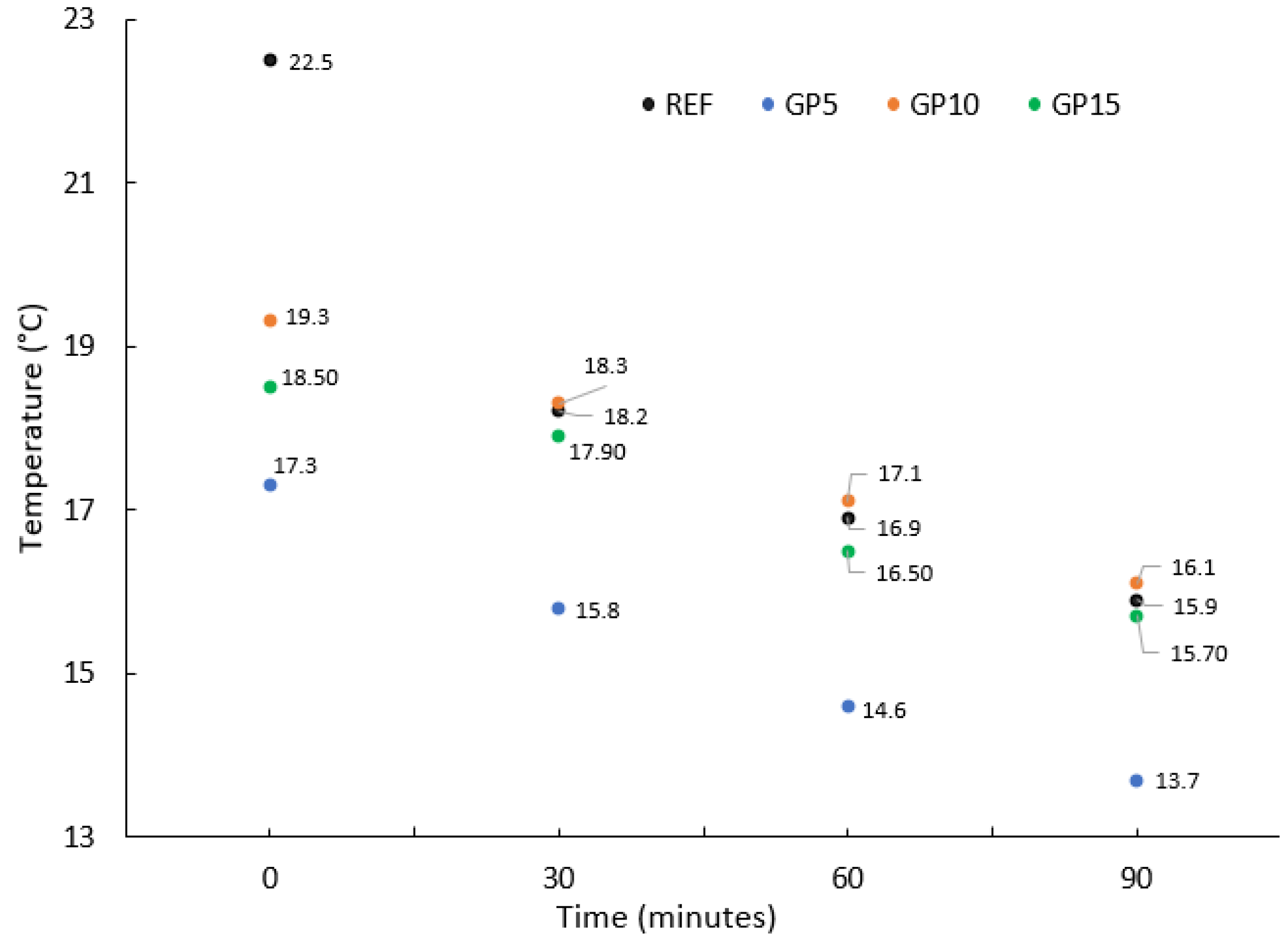
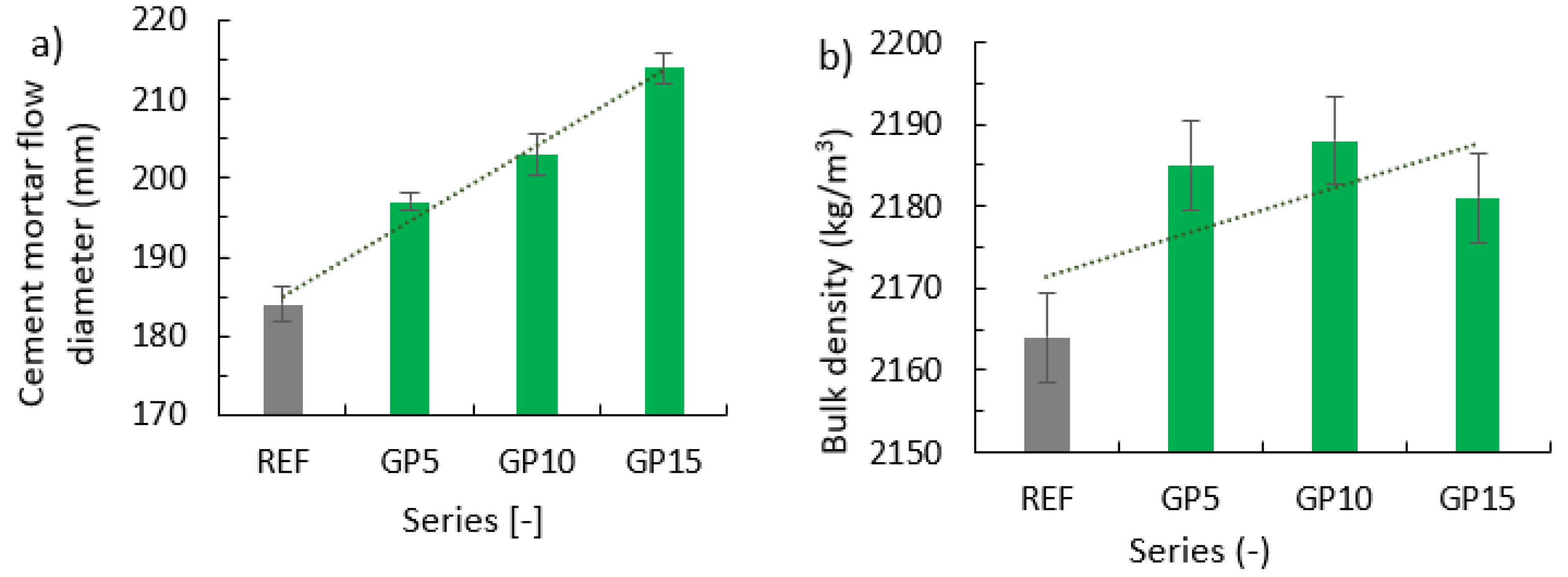

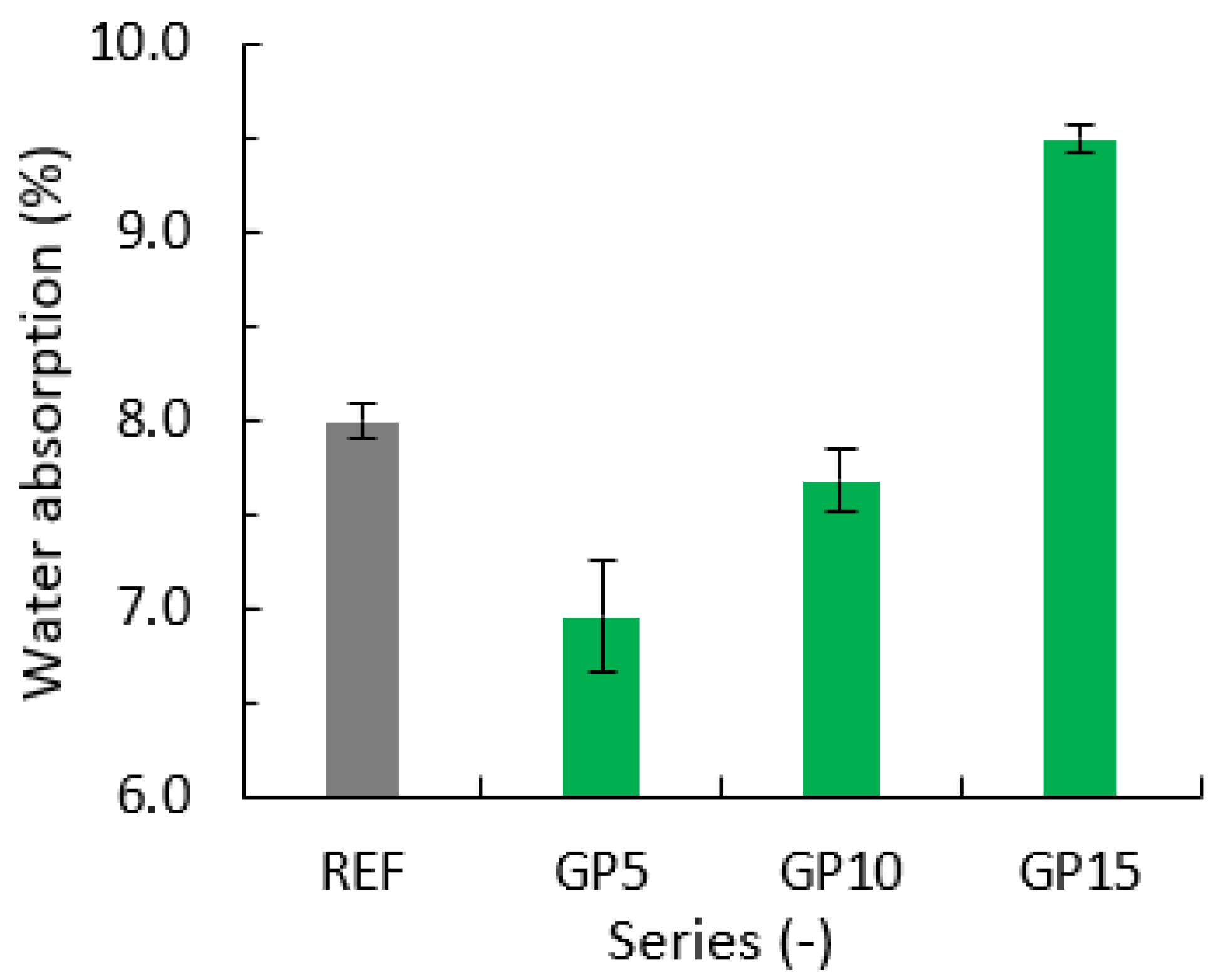
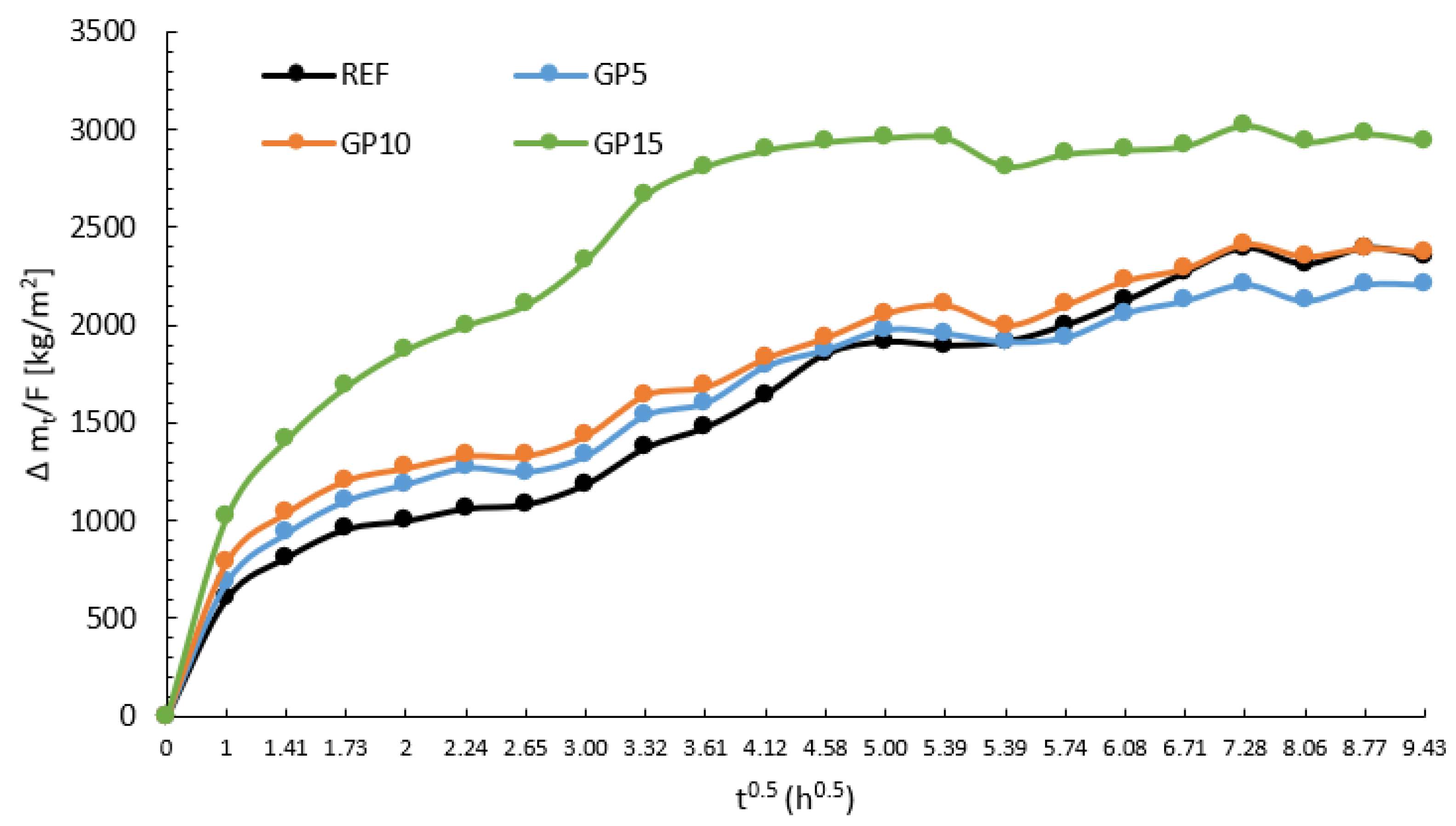
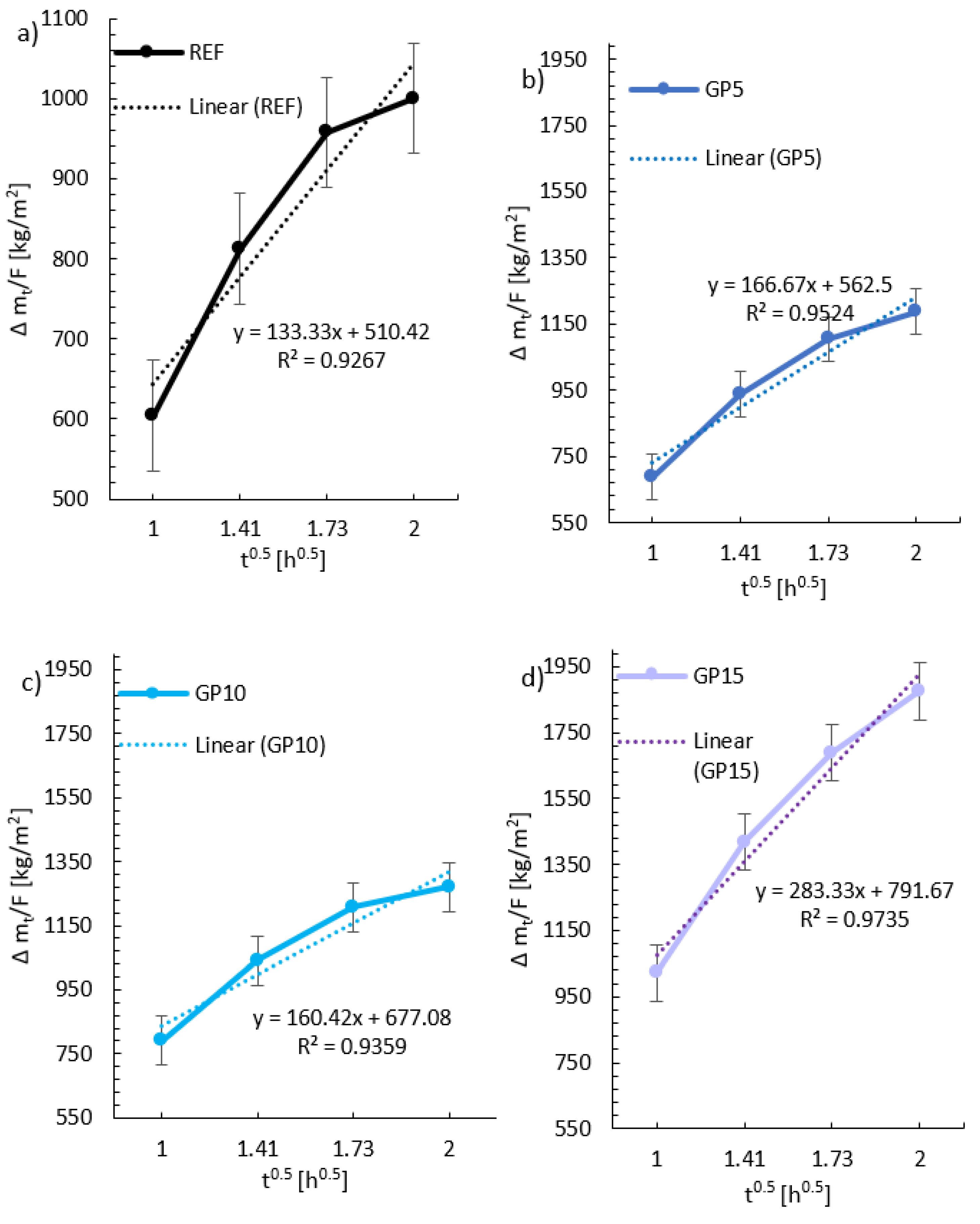
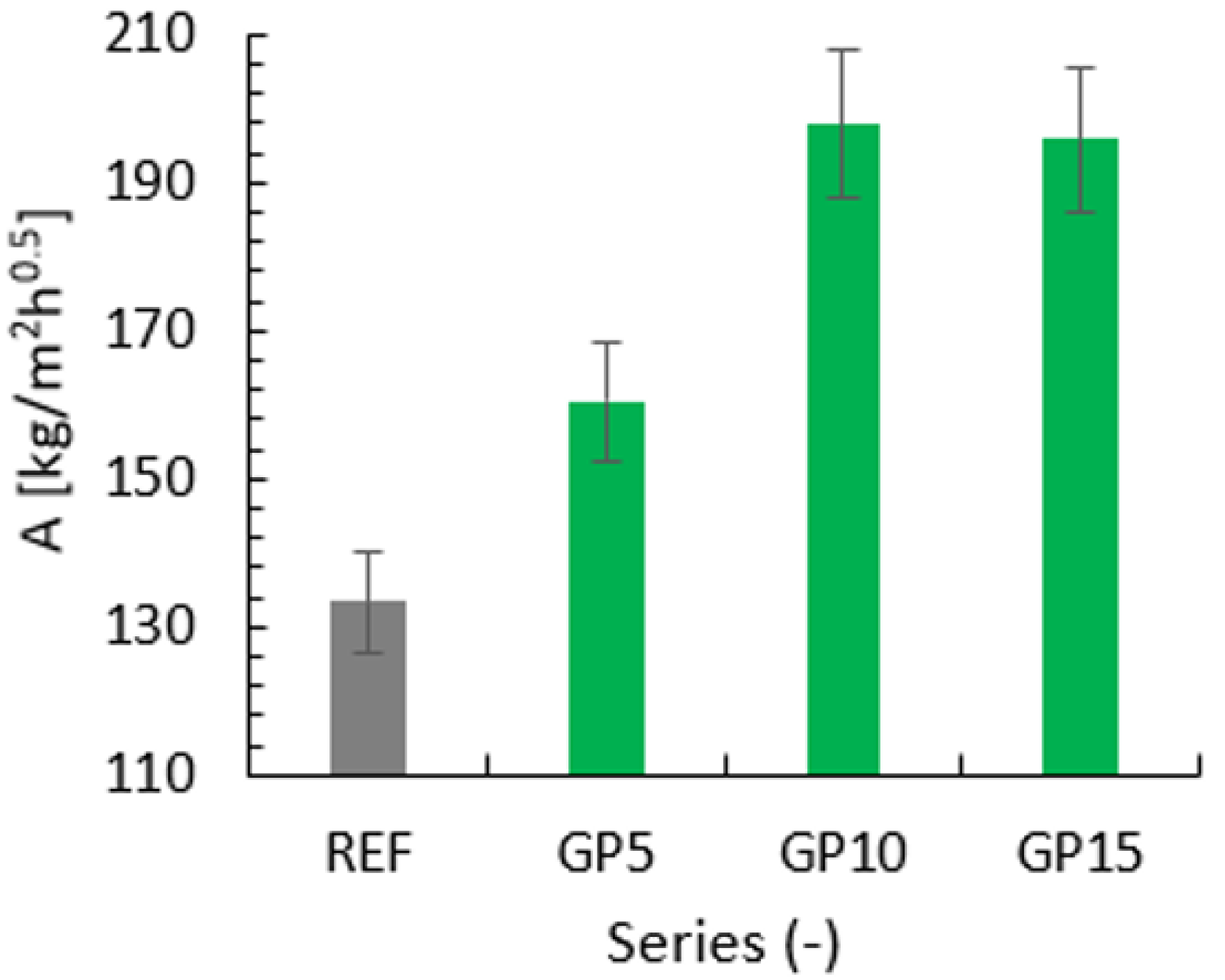
| Sieve Size (mm) | <0.02 | 0.02 | 0.032 | 0.063 | 0.1 | 0.14 |
|---|---|---|---|---|---|---|
| Passes through a sieve (%) | 0 | 5 | 51.9 | 82.9 | 90.2 | 100 |
| Chemical Compound | SiO2 | Al2O3 | Fe2O3 | CaO | MgO | FeO | NaO | K2O |
|---|---|---|---|---|---|---|---|---|
| Granite powder (%) | 54 | 20 | 2 | 8 | 6 | 4 | 3 | 3 |
| Series (-) | Portland Cement (%) | Granite Powder (%) | Aggregate (%) | Water (%) | Water/Cement Ratio | Water/Binder Ratio |
|---|---|---|---|---|---|---|
| REF | 21.45 | - | 64.34 | 14.21 | 0.66 | 0.66 |
| GP5 | 20.38 | 1.07 | 64.34 | 14.21 | 0.70 | 0.66 |
| GP10 | 19.30 | 2.14 | 64.34 | 14.21 | 0.74 | 0.66 |
| GP15 | 18.23 | 3.22 | 64.34 | 14.21 | 0.78 | 0.66 |
Publisher’s Note: MDPI stays neutral with regard to jurisdictional claims in published maps and institutional affiliations. |
© 2022 by the authors. Licensee MDPI, Basel, Switzerland. This article is an open access article distributed under the terms and conditions of the Creative Commons Attribution (CC BY) license (https://creativecommons.org/licenses/by/4.0/).
Share and Cite
Woźniak, Z.Z.; Chajec, A.; Sadowski, Ł. Effect of the Partial Replacement of Cement with Waste Granite Powder on the Properties of Fresh and Hardened Mortars for Masonry Applications. Materials 2022, 15, 9066. https://doi.org/10.3390/ma15249066
Woźniak ZZ, Chajec A, Sadowski Ł. Effect of the Partial Replacement of Cement with Waste Granite Powder on the Properties of Fresh and Hardened Mortars for Masonry Applications. Materials. 2022; 15(24):9066. https://doi.org/10.3390/ma15249066
Chicago/Turabian StyleWoźniak, Zuzanna Zofia, Adrian Chajec, and Łukasz Sadowski. 2022. "Effect of the Partial Replacement of Cement with Waste Granite Powder on the Properties of Fresh and Hardened Mortars for Masonry Applications" Materials 15, no. 24: 9066. https://doi.org/10.3390/ma15249066
APA StyleWoźniak, Z. Z., Chajec, A., & Sadowski, Ł. (2022). Effect of the Partial Replacement of Cement with Waste Granite Powder on the Properties of Fresh and Hardened Mortars for Masonry Applications. Materials, 15(24), 9066. https://doi.org/10.3390/ma15249066








